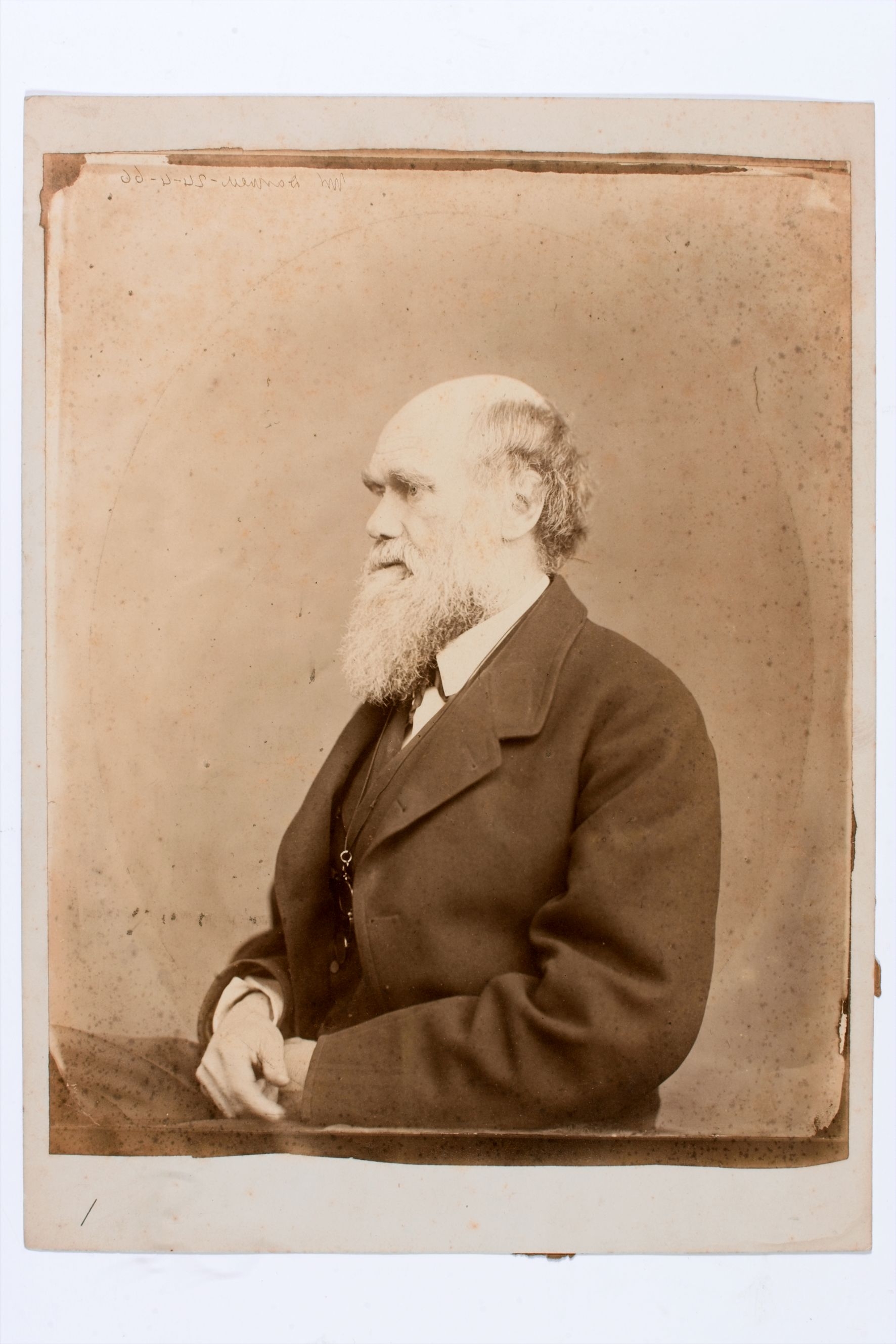On 28 March 1849, ten years before Origin was published, Darwin wrote to his good friend Joseph Hooker from Great Malvern in Worcestershire, where Dr James Manby Gully ran a fashionable water-cure establishment. Darwin apologised for his delayed reply to Hooker's letter which he put down to his exceptionally poor health:
Indeed all this winter, I have been bad enough, with dreadful vomiting every week, & my nervous system began to be affected, so that my hands trembled & head was often swimming. I was not able to do anything one day out of three, & was altogether too dispirited to write to you or to do anything but what I was compelled.- I thought I was rapidly going the way of all flesh. See the letter
At various periods in his life Darwin suffered from gastrointestinal distress - such as bouts of vomiting, retching, and bowel irregularity - as well as headaches, fatigue, trembling, faintness, and dizziness. In 1849, Darwin's symptoms became so severe that he removed his entire family to Malvern for three months while he took Dr Gully's water cure. In Darwin's letter to Hooker, he described Dr Gully's treatment:
At present, I am heated by Spirit lamp till I stream with perspiration, & am then suddenly rubbed violently with towels dripping with cold water: have two cold feet-baths, & wear a wet compress all day on my stomach. I eat simply, dine at 1 oclock & take several short walks daily. Even in first 8 days the treatment brought out an eruption all over my legs. I mention all this to you, as being a medical man, you might possibly like to hear about it.- I feel certain that the Water Cure is no quackery.- See the letter
After returning from Malvern, Darwin continued his hydropathic treatments in a specially built bath. Yet, the water cure did not live up to its name. Darwin experienced chronic episodes of ill health, which increased in severity in the years around 1848, 1852, 1859, and 1863. In a letter to Hooker in April of 1861, for example, Darwin used his delicate physiology to excuse himself from the bedside of his critically ill 'master & friend' John Stevens Henslow. Darwin was sure the journey from Down to Suffolk would cause all sorts of problems:
I shd. be certain to have severe vomiting afterwards, but that would not much signify, but I doubt whether I could stand the agitation at the time. I never felt my weakness a greater evil. I have just had specimen for I spoke a few minutes at Linn. Soc on Thursday & though extra well, it brought on 24 hours vomiting. I suppose there is some Inn at which I could stay, for I shd not like to be in the House (even if you could hold me) as my retching is apt to be extremely loud.- See the letter
Besides experimenting with hydropathic treatments at Malvern with Dr Gully, at Moor Park with Dr Edward Wickstead Lane, and at Ilkley with Dr Edmund Smith, Darwin sought advice from his consulting physician William Jenner, the stomach specialist William Brinton, and John Chapman, the purveyor of a fashionable spinal ice treatment. In April 1864, Darwin attributed his improved health to Dr Jenner's advice: 'drinking very little-enormous quantities of chalk, magnesia & Carb. of Ammonia has checked the vomiting wonderfully & I am gaining vigour.' (letter to J. D. Hooker, 13 April [1864])
Why was Darwin's so ill? Historians and others have speculated about the origin of Darwin's illnesses for decades. Some believe Darwin contracted Chagas' disease during the Beagle voyage; others retroactively diagnose him with hyperventilation, neurasthenia, hypoglycemia, lactose intolerance or other allergies; and still others argue that there were psychological or psychosomatic dimensions to Darwin's most severe periods of crisis. At the very least, it seems clear that Darwin's periods of ill health were quite useful. Citing a troubled stomach or a case of giddiness, Darwin could bow out of tedious social engagements, avoid traveling to London, and return to his study at Down to work.
Darwin's history of illness
Darwin often remarked that excitement, conversation with visitors, or any departure from his normal routines made him exhausted or sick, and he frequently excused himself from social occasions on these grounds (see, for example, Correspondence vol. 2, letter to J. S. Henslow, 14 October [1837], Correspondence vol. 7, letter to Robert Monsey Rolfe, 10 November [1858], and Correspondence vol. 12, letter to F. T. Buckland, 15 December [1864]).
On Darwin's early stomach troubles, see Correspondence vol. 2, letter to Caroline Wedgwood, [May 1838], and letter to Robert FitzRoy, [20 February 1840]. Darwin's health diary (Down House MS), which he kept between 1 July 1849 and 16 January 1855, describes almost daily occurrences of flatulence (see Colp 1977, pp. 46-7).
Darwin first mentioned attacks of 'periodical vomiting' in a letter to W. D. Fox, [7 June 1840] (Correspondence vol. 2). He suffered from persistent sickness in 1849, describing 'incessant vomiting' in his letter to Richard Owen, [24 February 1849], and 'vomiting every week' in his letter to J. D. Hooker, 28 March 1849 (Correspondence vol. 4). Throughout the winter of 1863 and spring of 1864, he was sick almost daily (see Correspondence vol. 12, letter from Emma Darwin to W. D. Fox, [6 May 1864]). According to Emma Darwin's diary (DAR 242), such regular attacks had occurred again in the last week of April 1865, and the third week of May, just before Darwin's decision to consult John Chapman. In a letter to J. D. Hooker, [20-] 22 February [1864] (Correspondence vol. 12), Darwin remarked that his vomiting usually occurred two to three hours after eating, and that he seldom threw up food. In his letter to Chapman of 16 May [1865], Darwin stated that his sickness was 'always caused by acid & morbid secretions'. Darwin had sometimes noted the acidity of his vomit in his health diary (Down House MS; see Colp 1977, p. 47).
Shivering or trembling, faintness, and black spots had been noted in journal entries and correspondence during periods of sickness in 1848, 1852, and 1859 (see Colp 1977, pp. 38, 47, 64). Fainting and 'rocking' had been recorded in Emma Darwin's diary (DAR 242) on several occasions in 1864 and 1865. 'Bad hysteria & sickness' were recorded in Emma Darwin's diary for 18 October 1864. No other record of 'hysterical crying' or 'dying sensations' has been found. On Darwin's reliance on Emma Darwin's companionship and care see, for example, Correspondence vol. 4, letter to Emma Darwin, [27-8 May 1848]. See also Browne 1995, pp. 428-9. On his difficulties reading, see letters to J. D. Hooker, 1 June [1865] and 27 [or 28 September 1865]. Emma or another member of the household regularly read to Darwin at intervals during the day and in the evening (see LL 1: 113, 118-19, 121-5, and A. Desmond and Moore 1991, pp. 359, 529).
Darwin believed that his father had suffered from gout (see Correspondence vol. 1, letter to W. D. Fox, [25-9 January 1829], and Correspondence vol. 2, letter to Sarah Elizabeth Wedgwood, [28 August 1837]). His grandfather, Erasmus Darwin, had described his own attacks of gout in his Commonplace book, p. 89 (Darwin Library-Down; see King-Hele 1999, pp. 161-2). Erasmus also wrote a letter to Darwin's father, in which he claimed that Darwin's great-grandfather, Charles Howard, had died of gout (see Autobiography, p. 224). Darwin discussed gout as an inherited disease in Variation 2: 7, 77-8. On Victorian views of hereditary illness, see Olby 1993.
Darwin's various skin conditions are discussed in Colp 1977, pp. 31-2, 47, 98. In his letter to J. D. Hooker, 5 March [1863] (Correspondence vol. 11), Darwin remarked: 'A good severe fit of Eczema would do me good & I have a touch this morning & consequently feel a little alive'. See also Correspondence vol. 12, letter from Emma Darwin to J. D. Hooker, 17 March [1864].
Treatments and medications
Darwin had undergone hydropathic treatment on occasions for many years and had initially been enthusiastic about the treatment (see, for example, Correspondence vol. 4, letter to W. D. Fox, 24 [March 1849], and Correspondence vol. 7, letter to W. D. Fox, 13 November [1858]). He first visited the establishment of James Manby Gully at Great Malvern, Worcestershire, where he and his family spent three months in March 1849 (see Correspondence vol. 4). He also took regular treatments in a specially built bath at Down for several years (see Correspondence vol. 4, letter to J. D. Hooker, 12 October 1849, and Colp 1977, pp. 43-6). He underwent hydropathic treatments at Moor Park, under Edward Wickstead Lane, between 1857 and 1859, and at Ilkley, under Edmund Smith, in 1859 (see Correspondence vols. 6 and 7). He also stayed at Lane's new establishment in Sudbrook Park, Surrey, at the end of June 1860 (Correspondence vol. 8). Darwin's last hydropathic treatment was taken at Malvern Wells, under James Smith Ayerst, in September and October 1863 (see Correspondence vol. 11, letter from Emma Darwin to W. D. Fox, 8 December [1863], and Appendix II). On Darwin's use of hydrotherapy, see Browne 1990, and for his consumption of alcohol, see LL 1: 118, and Colp 1977, p. 103.
Darwin tried a variety of medications over the course of his illness, including calomel (mercurous chloride), logwood, cinnamon, potassium bicarbonate, croton, aloe, bitters, bismuth nitrate, mineral acids and alkalies (see Colp 1977, pp. 12, 22, 37, 45-6, 65, 76, 78-80). Most recently, he had taken phosphate of iron as a tonic, and purgatives derived from Colchicum autumnale and Podophyllum peltatum (May apple) (see Correspondence vol. 12). A book of prescriptions used by the Darwin family, some of which are in Darwin's hand, is in Down House ('Receipts and memoranda book'), and has been transcribed in Colp 1977, pp. 147-67. Darwin began taking small, frequent doses of chalk, magnesia, and other antacids in March 1864 (see Emma Darwin's diary, DAR 242, and n. 8, above). He reported that the treatment, prescribed by Jenner, had checked his chronic vomiting (Correspondence vol. 12, letter to J. D. Hooker, 13 April [1864]).




